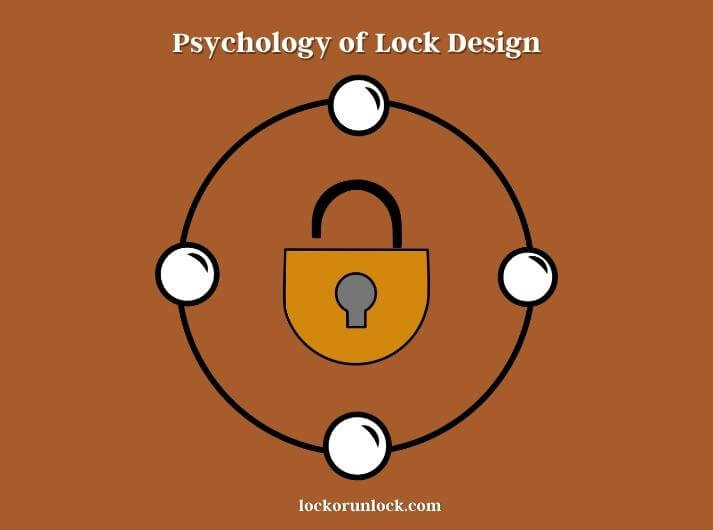Locks have been used for centuries to protect our possessions, homes, and businesses from theft and intrusion. Whether it’s a simple padlock on a shed or a high-tech smart lock on a front door, locks play an essential role in our daily lives.

Have you ever stopped to consider the psychology behind lock design and its impact on security? Understanding the psychology of lock design can help us better understand how locks work and how they can be improved to enhance security.
The Basics of Lock Design
The basics of lock design are important to understand before diving into the psychology of lock design and its impact on security. A lock is a mechanism used to prevent unauthorized access to something, such as a door, safe, or container. The first locks were made of wood and operated by a wooden key, but over time, locks have evolved to become more complex and secure.
Today, there are many types of locks available, each with its own unique design and purpose. For example, padlocks are portable locks that can be used to secure a variety of objects, while deadbolts are locks designed for use on doors. Smart locks are a more recent addition to the lock market and can be controlled using a smartphone or other device.
Regardless of the type of lock, they all share a few basic components. The key is used to operate the lock and can be either a physical key or an electronic code. The lock body is part of the lock that houses the mechanism that keeps it locked, and the keyhole is where the key is inserted to unlock the mechanism. The locking mechanism is what keeps the lock secure and can be anything from a simple latch to a complex series of tumblers and pins.

The design of a lock can impact its security, as a lock that is poorly designed can be more vulnerable to picking, drilling, or other methods of attack. Therefore, lock designers must consider the vulnerabilities of their designs when creating locks. Additionally, the design of a lock can impact its ease of use, with more complex designs potentially leading to user error and frustration.
The basics of lock design is essential for understanding the psychology of lock design and its impact on security. The components of a lock and how they are designed can impact the lock’s security and ease of use, and lock designers must take these factors into account when creating new locks.
Psychology of Lock Design
The psychology of lock design is a critical consideration for anyone involved in security. Lock designers must take into account the perception of security, cognitive load, and human behavior when creating locks.
Perception of Security
One of the primary psychological factors to consider when designing a lock is the perception of security. People may feel more secure with a lock that looks strong and sturdy, even if it is relatively easy to pick. This is because the perception of security is often based on the appearance of the lock rather than its actual effectiveness.
For example, a padlock with a thick shackle and a large body may be perceived as more secure than a smaller, more basic padlock, even if both locks are equally easy to pick.
Cognitive Load
Another psychological factor to consider is cognitive load, which refers to the mental effort required to use a lock. If a lock is too complex, users may struggle to remember how to operate it, potentially leading to security breaches. Lock designers must create locks that strike a balance between security and ease of use.

Human Behavior
Human behavior is also a critical consideration in lock design. For example, people may be more likely to forget to lock a door if the lock is too complicated, potentially leaving them vulnerable to theft.
Similarly, people may be more likely to leave a key in a lock if they are in a rush or if the lock is difficult to operate. Lock designers must take these behavioral factors into account when creating new locks to ensure that they are effective and user-friendly.
Impact of Lock Design on Security
The impact of lock design on security cannot be overstated. A well-designed lock can prevent theft, intrusion, and other security breaches, while a poorly designed lock can leave individuals and businesses vulnerable to attack. Let’s explore some examples of the impact of lock design on security.
Simple Padlock
A padlock is a popular lock used to secure everything from storage units to bicycles. Not all padlocks are created equal. Some are easier to pick or cut than others, leaving the secured item vulnerable to theft.
The design of the padlock is crucial to its effectiveness. A sturdy shackle, high-quality materials, and a complex locking mechanism can all contribute to making a padlock more secure.
Smart Locks
Smart locks are a recent addition to the lock market and can be controlled using a smartphone or other device. While these locks offer convenience, they also pose unique security challenges.
If a smart lock’s software is not secure, it may be vulnerable to hacking, potentially allowing intruders to gain access to a secured location. The design of smart locks must take into account both the convenience and security of the lock.
Door Locks
The impact of lock design on security can be seen in the case of door locks. Door locks are perhaps the most critical locks when it comes to security, as they prevent unauthorized access to a home or business.
Door locks can also be vulnerable to picking, bumping, or other methods of attack. Door lock designers must consider the psychological factors involved in the lock design, as well as the physical components, to create a lock that is both secure and easy to use.
The impact of lock design on security is significant. The design of a lock can impact its vulnerability to attack, its ease of use, and its effectiveness at preventing theft and intrusion.
Benefits of Lock Design
Lock design is an important aspect of security systems, and it can offer a wide range of benefits. Here are some of the key benefits of lock design:
Security
The primary benefit of lock design is security. A well-designed lock can prevent unauthorized access to a building, vehicle, or other valuable assets. Locks come in different types and styles, and they can be designed to withstand various forms of attacks, such as picking, drilling, and bumping.
Durability
Locks are often exposed to harsh weather conditions and physical abuse. A well-designed lock can withstand these conditions and remain functional for a long time. A durable lock can save money and prevent the need for frequent replacements. Proper lock maintenance is essential to keep your locks functioning correctly and ensure the safety and security of your home or business.
Ease of Use
A good lock design should be easy to use for authorized personnel. The lock should be easy to operate, and it should not require extensive training or knowledge to use. The lock should also be easy to install and maintain.
Aesthetics
Lock design can also contribute to the overall aesthetic of a building or vehicle. A well-designed lock can blend seamlessly with the surrounding architecture and enhance the overall appearance of the asset.
Customization
Lock design can be customized to meet the specific needs of different applications. For example, locks can be designed for different levels of security, different types of keys, and different methods of entry.
Conclusion
The design of locks plays a crucial role in ensuring security. The basics of lock design include physical components such as materials and locking mechanisms, while the psychology of lock design involves factors such as the perception of security, cognitive load, and human behavior. These considerations must be taken into account to create locks that are both effective and user-friendly.
The impact of lock design on security can be seen in various areas, including padlocks, smart locks, and door locks. The design of a lock can affect its susceptibility to attack, ease of use, and overall effectiveness at preventing theft and intrusion.
In today’s world, security is more critical than ever before. Lock design plays an essential role in securing homes, businesses, and valuable possessions.
